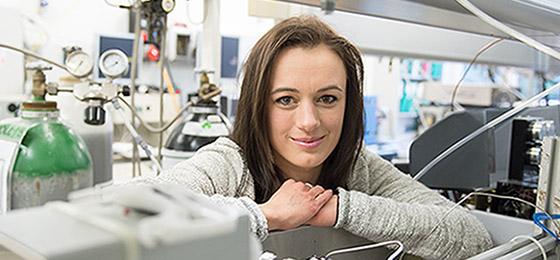The power of self-organisation

Thanks to her work on a new type of solar cell, Rita Tóth has been named a Leading Global Thinker by the US magazine Foreign Policy. A researcher in physical chemistry at Empa, Tóth first thought this was a hoax, but instead she ended up attending a political forum in Washington. By Florian Fisch
(From "Horizons" no. 105, June 2015)To capture the power in moth eyes. That is the reason why physical chemist Rita Tóth and four other scientists from the Swiss Federal Laboratories for Materials Science and Technology in Dübendorf near Zurich (Empa) and the University of Basel were listed among the 100 Leading Global Thinkers in the category of Innovators by Foreign Policy, a US magazine specialised in international relations. This also won them the attention of worldwide media such as The Economist and Le Monde.
What impressed the selection committee was the new type of solar cell designed
by Tóth and her colleagues. It converts sunlight directly into highly concentrated
chemical energy in the form of hydrogen gas – a kind of solar fuel. This would allow us to harness the power of the sun and, at the same time, to store energy that has been produced, when supply exceeds demand.
Hydrogen from the Sun
“When we received the letter from Foreign Policy we first thought it was a hoax”, recalls Tóth. But then the Empa team indeed took up the invitation to attend a fancy
political forum in a luxurious hotel in Washington D. C. By contrast, Tóth’s modest
demeanour does not really seem to suit someone who was mentioned in the same
breath as the German Chancellor Angela Merkel (interestingly, a former physical
chemist herself). Tóth is of small stature, is fine-featured and has a soft voice. When
she explains her work, she makes it sound so normal that it is sometimes difficult to
fathom its actual novelty.
The crucial part of the cell is a glass slide the size of a thumbnail, with a specially
treated surface. To test its efficiency, it is plunged into a slightly bigger glass container filled with a salt solution. Here, to mimic sunlight, it’s illuminated by a massive lamp the size of a shoe box.
The glass slide looks as if it has been sanded down. In reality, it is a fine layer
of rusted iron and tungsten. Negatively charged electrons are struck off it by the
photons of the sunlight, which leaves behind a positively charged ‘hole’. The art of
the physicist is to harness the potential of this separated state before the electrons
and the holes can recombine: they have to reach the surface and interact with the
salt solution at different locations in order to produce oxygen and hydrogen gas. These gases could subsequently be used to drive cars or to produce electricity.
“The novelty of our strategy is the way we structure the coating and thereby manage
the light”, explains Tóth. The light is trapped by small domes of rusted tungsten
that are less than a thousandth of a millimetre wide. Florent Boudoire, the PhD
student working with Tóth, found that trapping this light is also what happens
inside a moth’s eye. This is what helps it to see better at night while remaining
less visible to predators – and this is also a nice story that has served to capture the
journalistic imagination. “The size of the domes can easily be adjusted to tune light scattering and light trapping”, says Tóth. The additional thin layer of rusted iron
on top of the domes further increases the cell’s efficiency.
Chemicals as pathfinders
Mastering architectures like that of the coated domes is Tóth’s expertise: “I am interested in the self-organisation of materials”. This follows a bottom-up approach,
as opposed to the top-down strategy that is used, for example, in the production of
computer chips. The latter can be complex and expensive, the arrangement of materials being designed on a computer. “In the bottom-up approach, we just mix stuff and it happens spontaneously”, she explains in her typical tone of understatement.
The Hungarian researcher warms up when the discussion turns to her core interest.
“Self-organisation is everywhere: from flocks of birds and zebra stripes to human
social behaviour and the formation of galaxies. It has the potential to have a major
impact in technology and economics”. Using this self-organisation principle, Tóth
has enabled chemicals to find their way magically through a maze. The chemist
used tiny channels to represent the streets of downtown Budapest on a device the size
of a credit card. She filled them with a special mixture of alkaline and acidic chemicals to create a current, which automatically sucked a dye into the channels that
offered the shortest path from the university to the pizza store. The article about this
research was the most-read article of 2014 in Langmuir, an eminent journal of physical chemistry.
A self-organised life
Self-organisation also seems to be an appropriate way to describe Tóth’s scientific
career. She chose the University of Debrecen in the east of Hungary because it was
relatively close to her family. As for her decision to do a masters thesis in physical
chemistry, she says: “it was really choosing my teacher that led me to the topic”.
Tóth later joined research groups in the UK because she had already been collaborating with them at an earlier date. When the time came for her to leave the UK, her options were Brandeis University in the US, where she was offered a position, and Switzerland, where her British partner found a job in the pharmaceutical industry. So this was another self-regulatory choice: “Switzerland
was more or less halfway between both our families”.
Florian Fisch is a biologist and a science editor at the SNSF.